Learn how to make Turkish coffee that isn't bitter even without sugar! Includes iced and spiced options with step-by-step instructions. We're also going over the fascinating history of Turkish coffee that spans Sufi monks and Ottoman-era divorce rights of women.
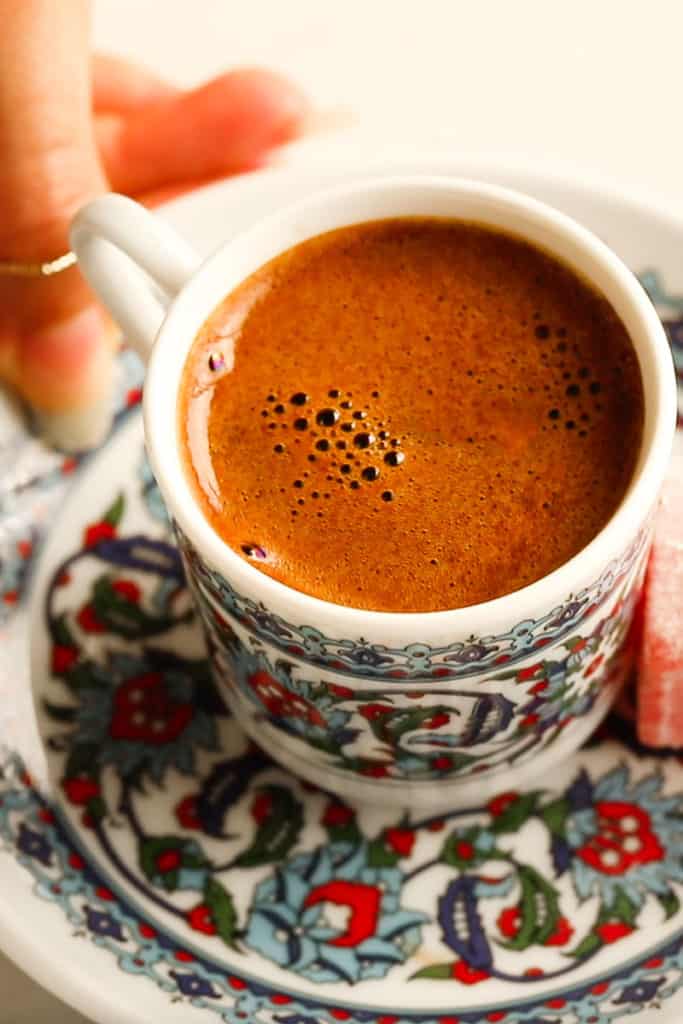
We’re making the perfect cup of classic Turkish coffee as well as some delicious varieties.
After reading this, you'll be armed with all the knowledge necessary to nail a foamy, yet not bitter, cup of kahve!
Jump to:
🎥 How to Make Turkish Coffee Step-by-Step Video
Want to see it all in action instead? Watch the full YouTube video below!
🇹🇷 History of Turkish Coffee
Although the coffee plant originated in Ethiopia, allegedly it was the Sufi monks of Yemen who made the first coffee drink in the 15th century.
They needed a way to stay awake all night while meditating, and no doubt—caffeine must have come in handy.
Then in 1517, the Ottoman Empire invaded Yemen. They brought some coffee back to the palace and the Ottomans were hooked.
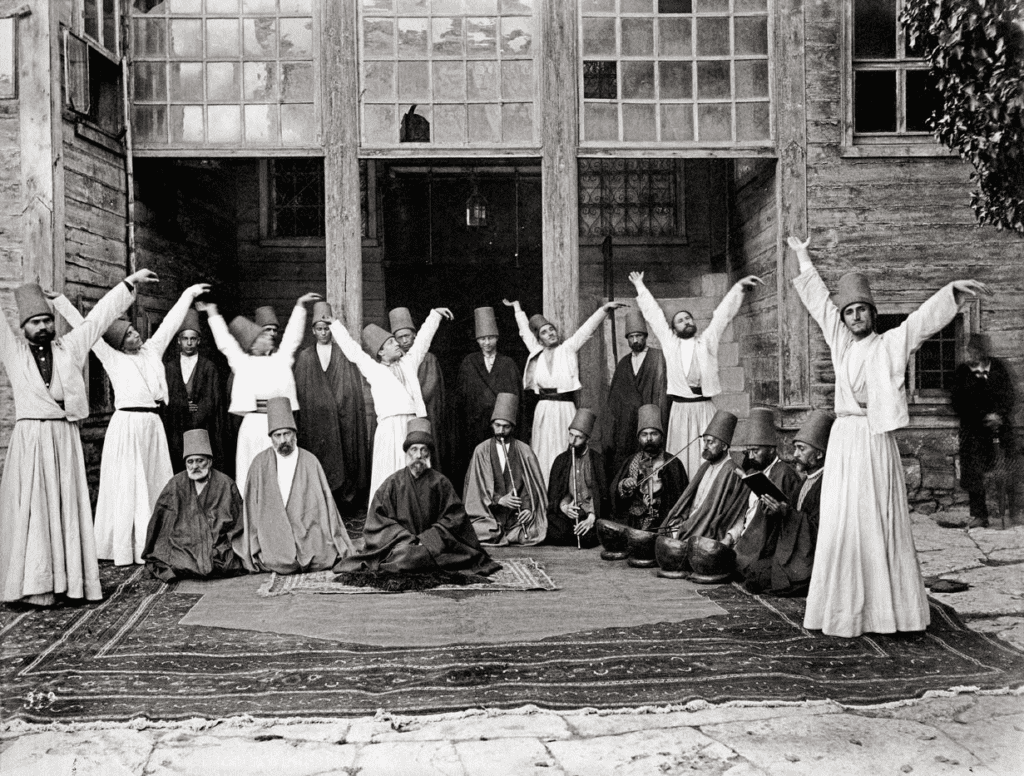
The very first public place serving coffee in the world is reported to be in Istanbul, by the name “Kiva Han”—which loosely translates into “coffee house” in Turkish.
The culture spread quickly. Throughout the Ottoman Empire, kahvehane (modern Turkish) became a place for men to socialize, and to eventually plan a revolution.
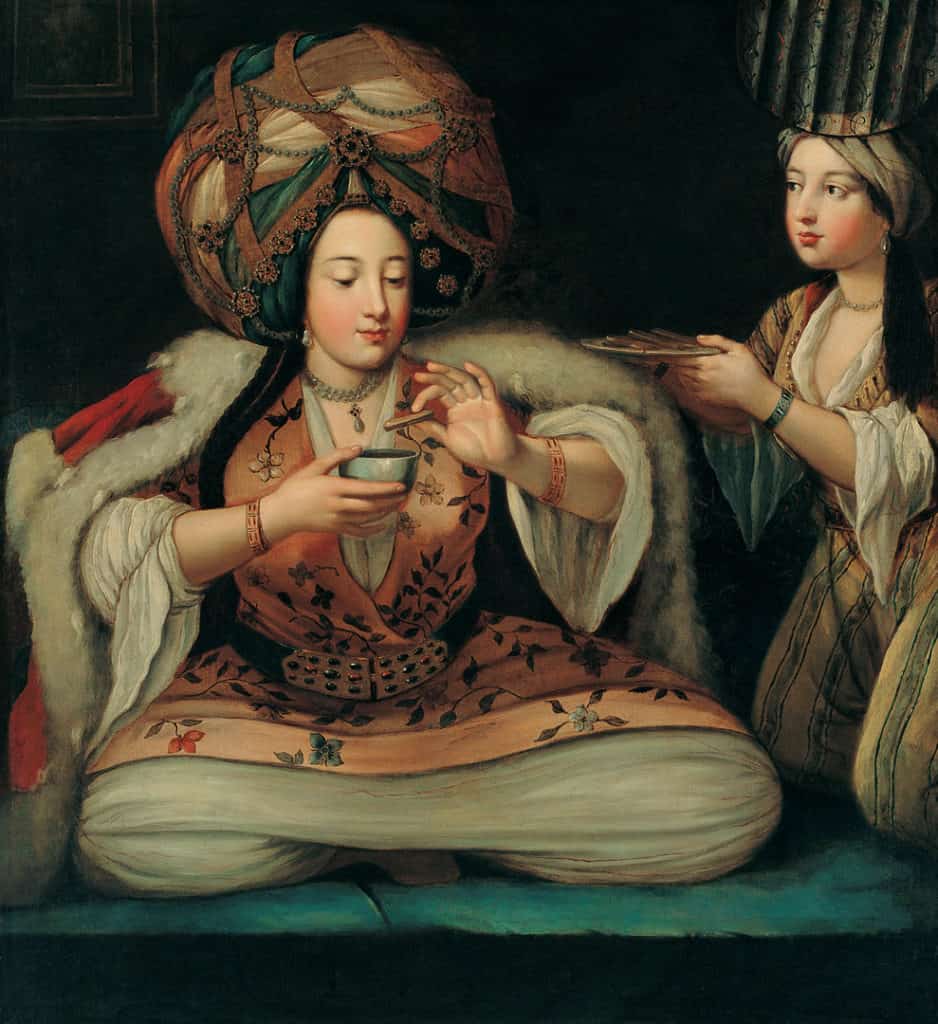
However, women were not allowed in coffee houses and could only enjoy coffee at home. So the men were tasked with providing their wives with sufficient coffee at all times.
If they failed to do so, the women could even divorce them according to the Sultan’s decree—which was quite extraordinary for the time.
Thankfully, since 1926, Turkish women have been able to get a divorce for not just lack of coffee, but for any reason.
Though even to this day, it’s still frowned upon for females to enter most traditional coffee houses.
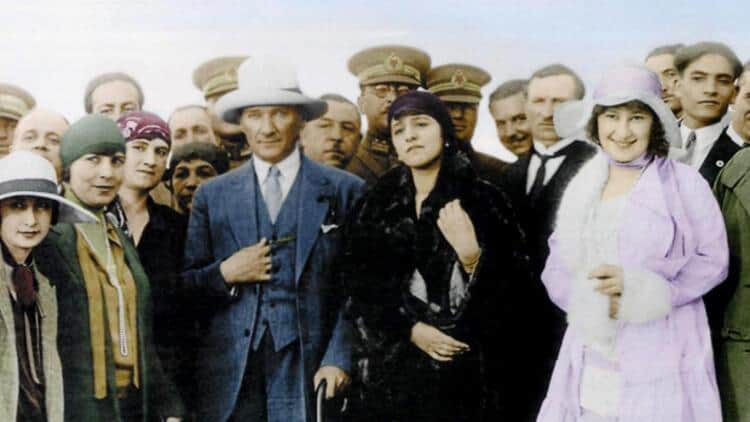
Is Turkish Coffee Turkish?
Yes, and no. Controversially, if we accept that it was indeed the Sufi monks of Yemen who made the first coffee drink—then we'd have to call it Yemeni coffee... but naming historic foods or drinks is never black and white.
Think of how we call Greek yogurt Greek even though many societies (including Turks) have been straining their yogurt for centuries. It's more related to marketing than historical origins.
You'll sometimes hear Turkish coffee being referred to as Greek, Arabic, or Bosnian coffee as well.
In fact, to avoid confusion or arguments, many coffee connoisseurs often call it “cezve or ibrik coffee”—which is the name of the vessel that it’s brewed in.
🫘 Details of Turkish Coffee
The Coffee Beans
The beans most widely used for Turkish coffee are medium or dark roast arabica beans from Brazil. But you can certainly use a specialty roast without fear of wasting it too.
The trick is to grind the beans extremely finely, even finer than you would for espresso. Think like flour or matcha, but a bit larger.
Many home coffee grinders don't have this finest setting available and the best (not to mention most aesthetic) option seems to be a hand grinder like this traditional copper one.
If you only have a coarser grind available, it's impossible to make proper Turkish coffee.
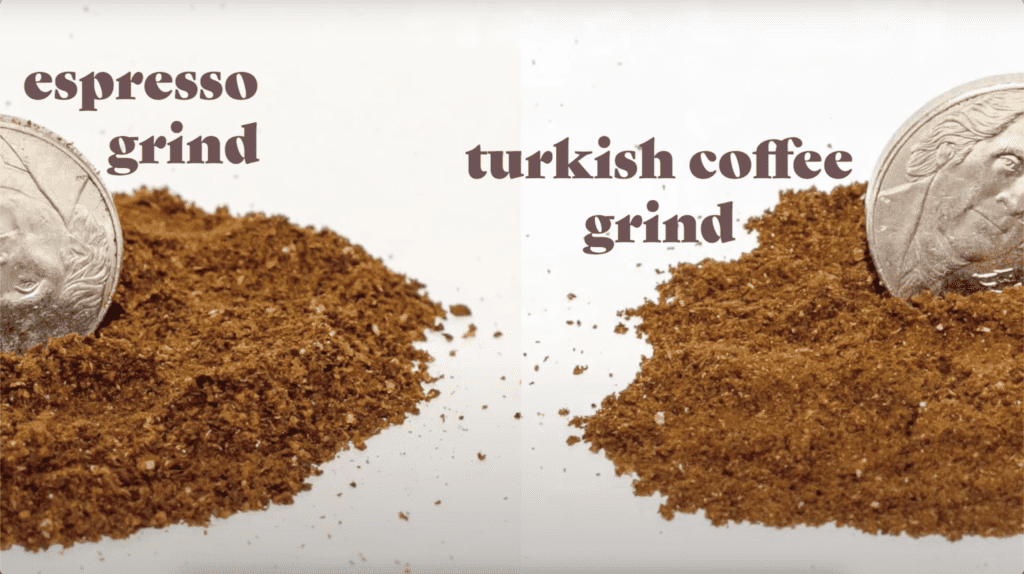
You may also purchase a pre-ground package from the famous shop Kuru Kahveci Mehmet Efendi, but it likely won’t be fresh and is a bit too finely ground—meaning it would be difficult to avoid the bitterness.
Though I've bought it on Amazon before and the taste wasn't bad at all, especially after adding some sugar.
Do You Need a Cezve or Ibrik to Make Turkish Coffee?
Ideally, yes. Mostly because the shape of the cooking vessel affects the amount of foam.
It's common for Turkish families to even have multiple sizes of cezve in order to make coffee according to the number of servings.
It's preferred for the mixed ingredients to reach as high as the thin part of the vessel, therefore making only one serving in a bigger cezve can be problematic.
If you're serious about Turkish coffee—I'd highly recommend this ibrik designed by the Turkish coffee master Turgay Yıldızlı. He certainly perfected the art. The method I'm following in this recipe is completely attributed to him.
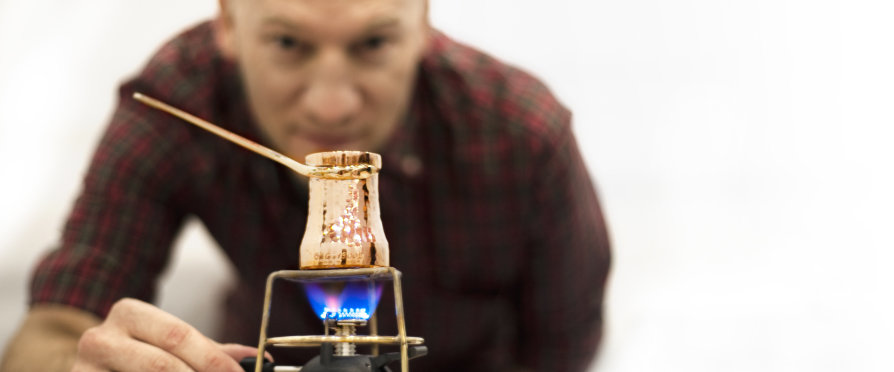
In case you don’t have an ibrik or cezve—use the smallest saucepan you have at home. Thinner and taller, the better.
Why So Bitter?
It really doesn't have to be bitter at all. The problem is how an "authentic" cup of Turkish coffee is made by agitating it to death and boiling—often multiple times to get more foam.
This results in over-extraction, which is responsible for that bitterness. That's why most people prefer to have their daily cup with at least some sugar and/or spices. You really do need it to mask the taste.
It's worth mentioning there exists a special type of coffee called "mırra" from the southeast region of Turkey.
It is known and appreciated for how bitter it is, and takes at least a couple of hours to make! If you ever make a trip out to that part of Anatolia, make sure to immerse yourself in that experience.
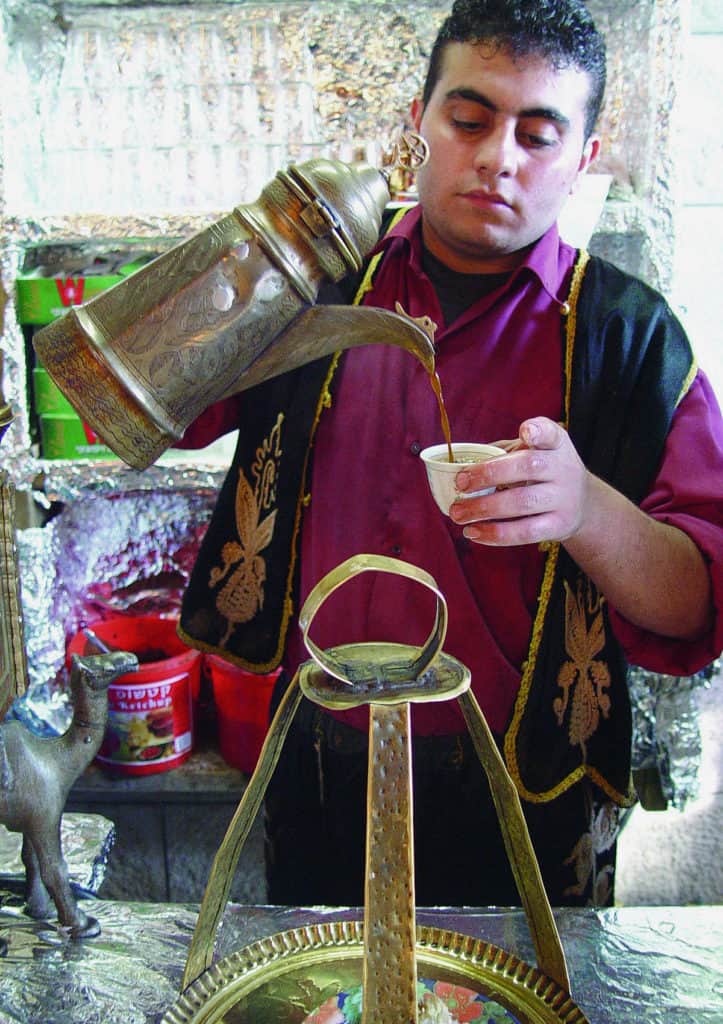
☕️ How to Make Turkish Coffee
Makes ½ cup, 2 servings (in espresso-sized cups).
Ingredients
- 14g (2 heaping tablespoons) ground Turkish coffee (See Note 1)
- 120ml (½ cup) water (See Note 2)
- optional: sugar (See Note 3)
- optional: ¼ teaspoon ground mastic or cardamom (See Note 4)
On the Side
- Turkish delight (or other small sweet treat)
- 1 cup of cold water
Notes on the Ingredients:
1. Turkish coffee is made with medium or dark-roast arabica beans. The grind size needs to be between powder and espresso.
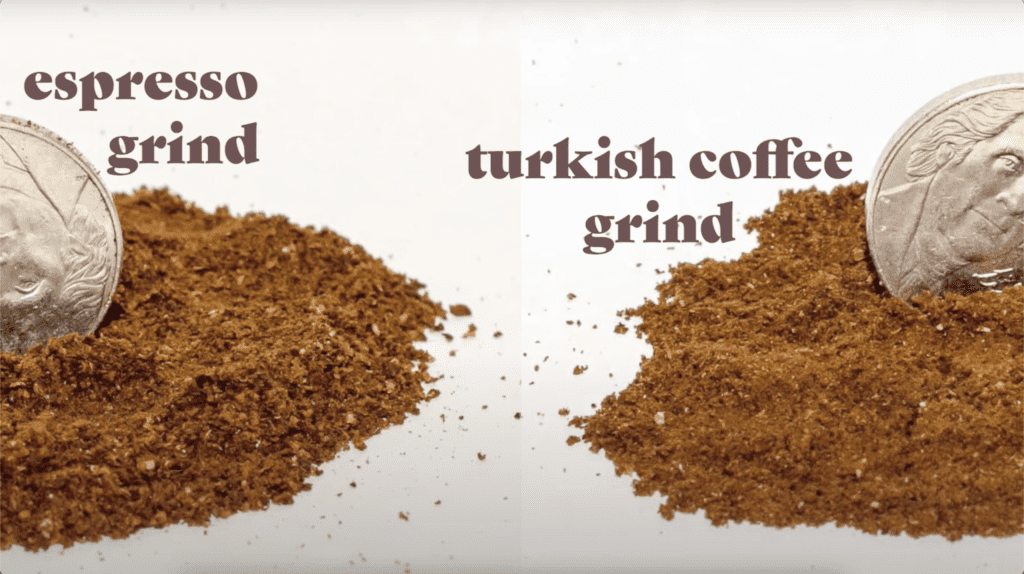
2. Most Turkish people don't weigh their coffee or water. The most common method is to measure a heaping tablespoon of ground coffee per each Turkish coffee cup's worth of water.
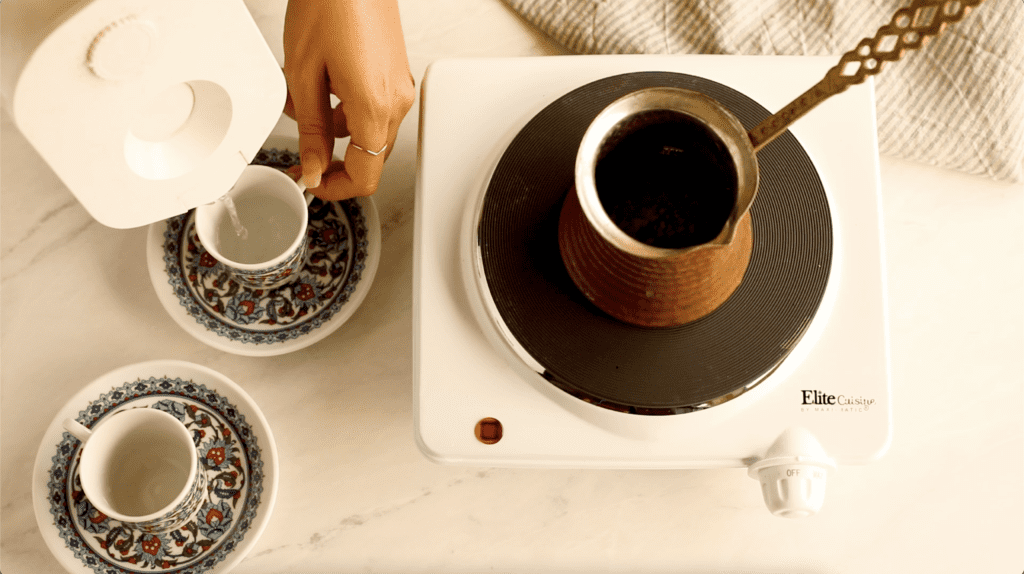
It is preferable for the water to be warm (140°F) in order to minimize brewing time, but room temperature water is okay.
3. Traditionally, there are four levels of sweetness. Below are the amounts of added sugar per Turkish coffee cup (per each ~60ml):
- Sade (no sugar)
- Az (lil' bit of sugar): ¼ teaspoon
- Orta (bit more sugar): ½ teaspoon
- Şekerli (with all the sugar): 1 teaspoon
4. In Turkey, coffee is mostly drunk without spices. However, the addition of ground mastic/mastic candy, or cardamom is popular in some regions.
Instructions
1. Add ground coffee and the optional sugar/spices to a cezve, slowly pour water, then gently stir a few times to remove the clumps.
2. Place the cezve over medium heat. Refrain from stirring while the coffee is brewing.
3. The coffee will be done within two to three minutes. Look for the moment when the island of foam starts to collapse in on itself, or the foam begins to rise rapidly. Make sure not to bring it to a boil. A longer brew time will result in over-extraction (bitter taste).
4. Slowly pour the coffee into a Turkish coffee cup at an angle.
5. Allow the coffee to settle for at least one minute, then serve with a glass of water and Turkish delight, or another small sweet treat. Make sure not to drink the grounds at the bottom of the cup.

🧊 Iced Turkish Coffee
Craving something colder? Try making iced Turkish coffee.
Simply pour a freshly-brewed cup of coffee over some ice, and add your favorite non-dairy milk. Dust with some cacao powder, and we have a very untraditional iced mocha!
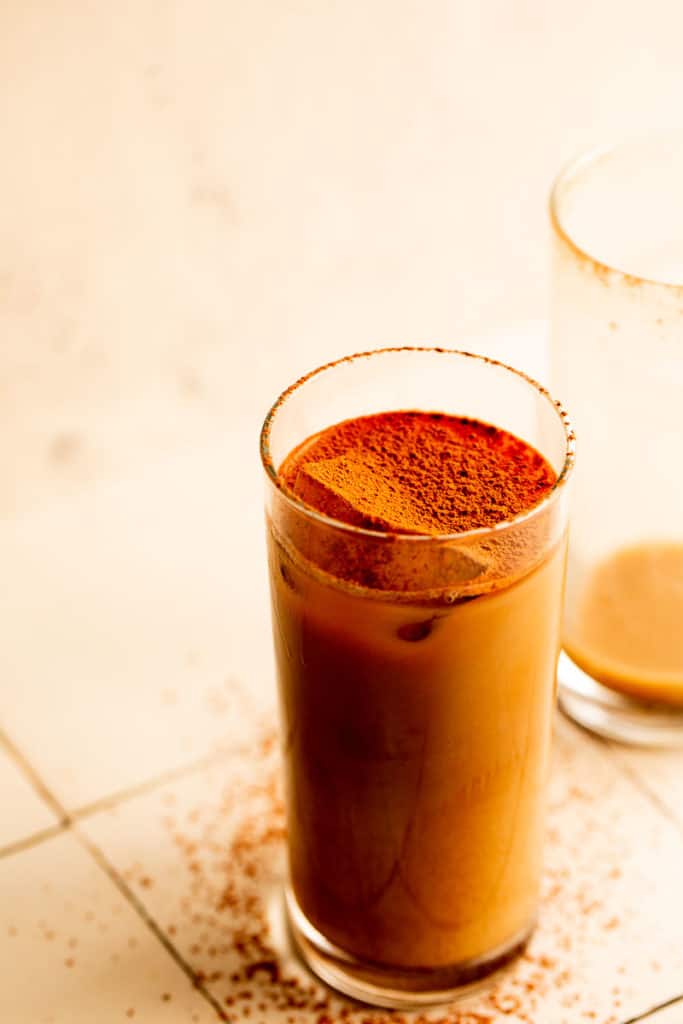
Coffee is kahve (KAH-va) in Turkish.
Turkish coffee is a thick, unfiltered type of coffee prepared in a cezve or ibrik using very finely ground coffee beans.
The leftover ground coffee beans are not drunk. Instead, some enjoy fortune-telling activities with the grounds—usually for fun purposes only.
Turkish coffee is supposed to be drunk slowly.
Although the coffee plant originated in Ethiopia, allegedly it was the Sufi monks of Yemen who made the first coffee drink in the 15th century. They needed a way to stay awake all night while meditating, and no doubt—caffeine must have come in handy.
Then in 1517, the Ottoman Empire invaded Yemen. They brought some coffee back to the palace and the Ottomans were hooked. The very first public place serving coffee in the world is reported to be in Istanbul, by the name “Kiva Han”—which loosely translates into “coffee house” in Turkish.
The culture spread quickly. Throughout the Ottoman Empire, kahvehane (modern Turkish) became a place for men to socialize, and to eventually plan a revolution.
Usually, Turkish coffee is very bitter. But it doesn't have to be! It can be made non-bitter by proper extraction methods outlined in the recipe.
The beans most widely used for Turkish coffee are medium or dark roast arabica beans from Brazil. But you can certainly use a specialty roast without fear of wasting it too.
The trick is to grind the beans extremely finely, even finer than you would for espresso. Think like flour or matcha, but a bit larger.
Many home coffee grinders don't have this finest setting available and the best (not to mention most aesthetic) option seems to be a hand grinder like this traditional copper one. If you only have a coarser grind available, it's impossible to make proper Turkish coffee.
Yes, and no. Controversially, if we accept that it was indeed the Sufi monks of Yemen who made the first coffee drink—then we'd have to call it Yemeni coffee... but naming historic foods or drinks is never black and white.
Think of how we call Greek yogurt Greek even though many societies (including Turks) have been straining their yogurt for centuries. It's more related to marketing than historical origins.
You'll sometimes hear Turkish coffee being referred to as Greek, Arabic, or Bosnian coffee as well. In fact, to avoid confusion or arguments, many coffee connoisseurs often call it “cezve or ibrik coffee”—which is the name of the vessel that it’s brewed in.
🫖 Other Drinks You May Enjoy
Here are some other delicious drinks to try!
Did you make this Turkish coffee recipe? I'd love to hear about it! Please comment and leave a star🌟 rating below. This helps me run Aegean Delight and I always appreciate it 🙂
Print📖 Recipe

How to Make Turkish Coffee with Step-by-Step Instructions
- Total Time: 4 minutes
- Yield: Makes ½ cup, 2 servings (in espresso-sized cups) 1x
- Diet: Vegan
Ingredients
- 14g (2 heaping tablespoons) ground Turkish coffee (See Note 1)
- 120ml (½ cup) water (See Note 2)
- optional: sugar (See Note 3)
- optional: ¼ teaspoon ground mastic or cardamom (See Note 4)
On the Side:
- Turkish delight (or other small sweet treat)
- 1 cup of cold water
Notes on the Ingredients:
1. Turkish coffee is made with medium or dark-roast arabica beans. The grind size needs to be between powder and espresso.

2. Most Turkish people don't weigh their coffee or water. The most common method is to measure a heaping tablespoon of ground coffee per each Turkish coffee cup's worth of water.

It is preferable for the water to be warm (140°F) in order to minimize brewing time, but room temperature water is okay.
3. Traditionally, there are four levels of sweetness. Below are the amounts of added sugar per Turkish coffee cup (per each ~60ml):
- Sade (no sugar)
- Az (lil' bit of sugar): ¼ teaspoon
- Orta (bit more sugar): ½ teaspoon
- Şekerli (with all the sugar): 1 teaspoon
4. In Turkey, coffee is mostly drunk without spices. However, the addition of ground mastic/mastic candy, or cardamom is popular in some regions.
Instructions
1. Add ground coffee and the optional sugar/spices to a cezve, slowly pour water, then gently stir a few times to remove the clumps.
2. Place the cezve over medium heat. Refrain from stirring while the coffee is brewing.
3. The coffee will be done within two to three minutes. Look for the moment when the island of foam starts to collapse in on itself, or the foam begins to rise rapidly. Make sure not to bring it to a boil. A longer brew time will result in over-extraction (bitter taste).
4. Slowly pour the coffee into a Turkish coffee cup at an angle.
5. Allow the coffee to settle for at least one minute, then serve with a glass of water and Turkish delight, or another small sweet treat. Make sure not to drink the grounds at the bottom of the cup.

- Prep Time: 1 minute
- Cook Time: 3 minutes
- Category: Drinks
- Method: Cook
- Cuisine: Turkish







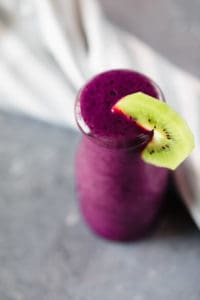
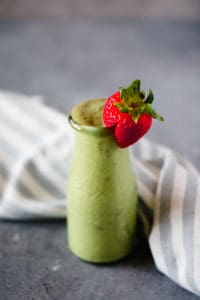
Mo
I went to Dubai last year and had the most amazing cup of Turkish coffee at a Turkish coffee house. It wasn’t bitter at all. They told me the most important thing is not to cook it too long. I made this (with kurukahveci brand) and it’s exactly like the one in Dubai! Thank you very much
Gönül
I'm so happy to hear you had a similar experience! Bitter coffee has its place for sure, but I definitely prefer this method too 🙂 Thanks!
Maria Hastings
Thank you so much for this easy to follow recipe and instructions. My mother is armenian and she made turkish coffee on the weekends and after finishing our coffee we would flip the cup over on a saucer and let the mud drip down the inside until it dried. My mother would then read our cups. I wanted to surprise my mother by making her some turkish coffee and she was so proud of me and how well it turned out.
Gönül
Thanks so much for giving it a try and leaving a review, Maria! That is such a heartwarming story, my mother and I have similar memories 🙂 I am so glad she enjoyed your surprise!
Cheers,
Gonul
Misty
I loved this historically educational turtorial, bravo! Next, will try the method, but am already certain it will be lovly! Going to do it over the campfire coals in the morning while we are camping. ❤️
Gönül
Thank you so much for your kind words, Misty! That is very sweet of you 🙂
Making Turkish coffee over a campfire is something I'd love to try! Sounds amazing!!
xoxo,
Gonul
Rebecca
Good morning from California. Making this now using pre-ground coffee that I didn't realize is an espresso grind.
I love the design on your cup and saucer. Will you share where these are from please?
Well, I didn't get the pretty crema, but it is delicious and not bitter. Thank you for the lovely tutorial.
Gönül
Good morning to you as well, Rebecca 🙂
Glad to hear you've enjoyed the taste! There is a fine balance between agitation (that leads to bitterness) and the amount of crema I'm afraid. The cups we've used were bought in Turkey, but this set is almost identical: https://www.amazon.com/Turkish-Coffee-Saucer-Sets-Pieces/dp/B085ZL6SL7/
Hope this helps!
Cheers
Marie
Thank you, this answered a lot of my questions.
Gönül
My pleasure! 🙂
Danny
I love the detail in those pictures!
May I ask what camera you use?
Gönül
Thanks so much! I use a Canon 5D Mark IV body with a 100mm prime or 28-70mm zoom lens. Some photos are from an iPhone. Hope this helps!